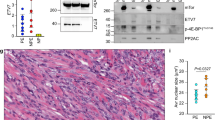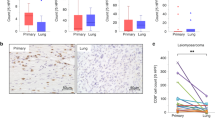Abstract
PSA is an oncodevelopmental antigen usually expressed in human tumors with high metastatic potential. Here we set up a metastatic model in nude mice by using TE671 cells, which strongly express PSA-NCAM. We observed the formation of lung metastases when TE671 cells were injected intravenously, intramuscularly, and intraperitoneously, but not subcutaneously. Intraperitoneous injections also induced peritoneal carcinosis, ascites, and liver metastases. To evaluate the putative role of PSA in the metastatic process we used a specific cleavage of PSA on NCAM by endoneuraminidase-N on intraperitoneous primary tumors. Mice with primary intramuscular tumors were taken as control. Repeated injections of endoneuraminidase-N led to a decrease in PSA expression in primary intraperitoneous nodules and ascites but not in intramuscular primary tumors. Endoneuraminidase-N also increased the delay in ascitic formation and decreased the number of lung or liver metastases in the case of intraperitoneous tumors but not in the case of intramuscular tumors. When metastases occurred in endoneuraminidase-N injected animals, they strongly expressed PSA-NCAM. Therefore, we established a relationship between PSA expression on the surface of primary tumor cells and the metastatic process.
This is a preview of subscription content, access via your institution
Access options
Subscribe to this journal
Receive 50 print issues and online access
$259.00 per year
only $5.18 per issue
Buy this article
- Purchase on Springer Link
- Instant access to full article PDF
Prices may be subject to local taxes which are calculated during checkout







Similar content being viewed by others
References
Acheson A, Sunshine JL and Rutishauser U. . 1991 J. Cell. Biol. 114: 143–153.
Aznavoorian S, Murphy AN, Stetler-Stevenson WG and Liotta LA. . 1993 Cancer 71: 1368–1383.
Barr FG. . 1997 J. Pediatr. Hematol. Oncol. 19: 483–491.
Bresalier RS, Ho SB, Schoeppner HL, Kim YS, Sleisenger MH, Brodt P and Byrd JC. . 1996 Gastroenterol. 110: 1354–1367.
Cremer H, Lange R, Christoph A, Plomann M, Vopper G, Roes J, Brown R, Baldwin S, Kraemer P, Scheff P, Barthels D, Rajewsky K and Wille W. . 1994 Nature 367: 455–459.
Daniel L, Trouillas J, Renaud W, Chevallier P, Gouvernet J, Rougon G and Figarella-Branger D. . 2000 Cancer Res. 60: 80–85.
Dubois C, Okandze A, Figarella-Branger D, Rampini C and Rougon G. . 1995 J. Immunol. Methods 181: 125–135.
Figarella-Branger D, Pellissier JF, Bianco N, Pons F, Leger JJ and Rougon G. . 1992 J. Neuropathol. Exp. Neurol. 51: 12–23.
Figarella-Branger D, Durbec P and Rougon G. . 1990 Cancer Res. 50: 6364–6370.
Figarella-Branger D, Dubois C, Chauvin P, De Victor B, Gentet JC and Rougon G. . 1996 J. Clin. Oncol. 14: 2066–2072.
Finne J, Finne U, Deagostini-Bazin H and Goridis C. . 1983 Biochem. Biophys. Res. Commun. 112: 482–487.
Gaffney EF, Dervan PA and Fletcher CDM. . 1993 Am. J. Surg. Pathol. 17: 601–609.
Glüer S, Schelp C, Von Schweinitz D and Gerardy-Schahn R. . 1998a Pediatr. Res. 43: 145–147.
Glüer S, Schelp C, Madry N, Von Schweinitz D, Eckhardt M and Gerardy-Schahn R. . 1998b Brit. J. Cancer. 78: 106–110.
Gokal R. . 1992 Peritoneal dialysis. In: Oxford Textbook of Clinical Nephrology. Cameron JS, Davison AM, Grunfeld JP, Kerr DNS and Ritz E. (eds). Oxford University Press: London pp. 1477–1505.
Hu HY, Tomasiewicz H, Magnuson T and Rutishauser U. . 1996 Neuron 16: 735–743.
Husmann M, Pietsch T, Fleischer B, Weisberger C and Bitter-Suermann D. . 1989 Eur. J. Immunol. 19: 176–180.
Kubota T. . 1994 J. Cell. Biochem. 56: 4–8.
Lackie PM, Zuber C and Roth J. . 1990 Development 110: 933–947.
MacAllister RM, Isaacs H and Rongey R. . 1977 Int. J. Cancer 20: 206–212.
Mayanil CS, George D, Mania-Farnell B, Bremer CL, MacLone DG and Bremer EG. . 2000 J. Biol. Chem. 275: 23259–23266.
Molenaar WM, De Leij L and Trojanowski JQ. . 1991 Acta Neuropathol. 83: 46–54.
Navarro P, Gomez M, Pizzaro A, Gamallo C, Quintanilla M and Cano A. . 1991 J. Cell. Biol. 115: 517–533.
Ono K, Tomasiewicz H, Magnuson T and Rutishauser U. . 1994 Neuron 13: 595–605.
Ousmenar BN, Vignais L, Duhamel-Clerin E, Avellana-Adalid V, Rougon G and Baron van Evercooren A. . 1995 Eur. J. Neurosci. 7: 480–491.
Parish RW, Schmidhauser C, Schmidt T and Dudler R. . 1987 J. Cell. Sci. 8: 181–197.
Rapoport J, Hausmann MJ and Chaimmovitz C. . 1999 Nephron 81: 375–380.
Rougon G, Dubois C, Buckley N, Magnani JL and Zollinger W. . 1986 J. Cell. Biol. 103: 2429–2437.
Rougon G and Marshak DR. . 1986 J. Biol. Chem. 261: 3396–3401.
Rougon G. . 1993 Eur. J. Cell. Biol. 61: 197–207.
Rougon G, Olive S and Figarella-Branger D. . 1993 Polysialic Acid. Roth JR, Rutishauser U and Troy FA. (eds). Birkhauser-Verlag: Basel pp. 323–333.
Rutishauser U, Acheson A, Hall AK, Mann DM and Sunshine J. . 1988 Science 240: 53–57.
Sadoul R, Hirn M, Deagostini-Bazin H, Rougon G and Goridis C. . 1983 Nature 304: 347–349.
Scheiddeger EP, Lackie LM, Papay J and Roth J. . 1994 Lab. Invest. 70: 95–106.
Silobrcic V, Zietman AL, Ramsey JR, Suit HD and Sedlacek RS. . 1990 Int. J. Cancer 45: 325–333.
Storms SD and Rutishauser U. . 1998 J. Biol. Chem. 273: 27124–27129.
Stratton MR, Reeves BR and Cooper CS. . 1989 Nature 337: 311–312.
Theodosis DT, Bonhomme R, Vitiello S, Rougon G and Poulain DA. . 1999 J. Neurosci. 19: 10228–10236.
Togo S, Shimada H, Kubota T, Moosa AR and Hoffman RM. . 1995 Cancer Res. 55: 681–684.
Wang C, Rougon G and Kiss JZ. . 1994 J. Neurosci. 14: 4446–4457.
Wichterle H, Garcia-Verdugo JM and Alvarez-Buylla A. . 1997 Neuron 18: 779–791.
Yokota J. . 2000 Carcinogenesis 21: 497–503.
Acknowledgements
We thank J Barbet and JF Pellissier for comments, J Gouvernet for statistical analyses, and G Burkhart for technical assistance. The karyotypic analysis of TE 671 cell line was performed by H Zattara-Cannoni (Service de Cytogénétique, Timone Hospital, Marseille, France). This work was supported by grants from the ‘Association pour la Recherche contre le Cancer’ (to D Figarella-Branger and to G Rougon), the GEFLUC (Groupement des Entreprises Françaises dans la Lutte contre le Cancer) (to D Figarella-Branger), PHRC (to D Figarella-Branger) and institutional grants (to JE 2053).
Author information
Authors and Affiliations
Rights and permissions
About this article
Cite this article
Daniel, L., Durbec, P., Gautherot, E. et al. A nude mice model of human rhabdomyosarcoma lung metastases for evaluating the role of polysialic acids in the metastatic process. Oncogene 20, 997–1004 (2001). https://doi.org/10.1038/sj.onc.1204176
Received:
Revised:
Accepted:
Published:
Issue Date:
DOI: https://doi.org/10.1038/sj.onc.1204176
Keywords
This article is cited by
-
Physical biology of the cancer cell glycocalyx
Nature Physics (2018)
-
Intrabodies against the Polysialyltransferases ST8SiaII and ST8SiaIV inhibit Polysialylation of NCAM in rhabdomyosarcoma tumor cells
BMC Biotechnology (2017)
-
Sialylation of N-glycans: mechanism, cellular compartmentalization and function
Histochemistry and Cell Biology (2017)
-
N-Propionyl polysialic acid precursor enhances the susceptibility of multiple myeloma to antitumor effect of anti-NprPSA monoclonal antibody
Acta Pharmacologica Sinica (2012)
-
Immunization with N-propionyl polysialic acid–KLH conjugate in patients with small cell lung cancer is safe and induces IgM antibodies reactive with SCLC cells and bactericidal against group B meningococci
Cancer Immunology, Immunotherapy (2012)



